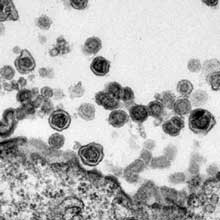 Dr. Goff, one of the top retrovirologists in the field, taked with Dr. Racaniello about XMRV for almost an hour. This was a rare opportunity to hear how experts in the field assess the XMRV/CFS connection. Here’s my take on what they said from the XMRV Buzz Page
Dr. Goff, one of the top retrovirologists in the field, taked with Dr. Racaniello about XMRV for almost an hour. This was a rare opportunity to hear how experts in the field assess the XMRV/CFS connection. Here’s my take on what they said from the XMRV Buzz Page
XMRV and the Prostate – One way researchers figure out which types of cells a virus infects and which parts of the body it may damage is to determine which cells have receptors for it. Receptors are like hooks the virus can use to get into the cell and different cells will have different receptors. Despite XMRV’s ability to grow in prostate cancer cells they do not have high levels of the receptor XMRV it needs to enter the cell. So why is it there? Because prostate cells have a ‘transcription factor’ XMRV use to help it replicate – so if it XMRV gets into a prostate cell there’s a good chance it can start ‘reproducing’. The researchers were surprised how vigorously XMRV grows in prostate cancer cell lines.
In fact, researchers have known of murine leukemia viruses – the type of virus XMRV closely resembles – for quite some time but they didn’t get much interest because once these viruses got into a cell they generally didn’t do much; they were considered ‘weak viruses’. That was before they attempted to culture in the cells they’re using now. Interestingly XMRV doesn’t appear to do much in the immune cells it has been found in CFS – it appears to be a ‘weak virus’ , at least with regards its ability to replicate, in immune cells. (There are other ways it can do damage).
 Cancer Virus or Not? – There’s been a lot of speculation about XMRV’s ability to cause cancer given the propensity of similar viruses to insert themselves in areas of the genome populated by oncogenes – genes that can turn cells cancerous. Dr. Goff said, though, that none of the researchers that have looked at the ‘integration sites’ of XMRV in prostate cells have found that it’s been inserted near an oncogene thus XMRV’s cancer causing properties are unclear – it may not be the cancer causing virus researchers have thought it was.
Cancer Virus or Not? – There’s been a lot of speculation about XMRV’s ability to cause cancer given the propensity of similar viruses to insert themselves in areas of the genome populated by oncogenes – genes that can turn cells cancerous. Dr. Goff said, though, that none of the researchers that have looked at the ‘integration sites’ of XMRV in prostate cells have found that it’s been inserted near an oncogene thus XMRV’s cancer causing properties are unclear – it may not be the cancer causing virus researchers have thought it was.
XMRV Jumps Into the Human Race – Given the remarkable similarity between XMRV and murine leukemia viruses researchers have thought that XMRV must have ‘jumped’ into humans recently – within the last couple of 1000 years. Dr. Goff said that the various isolates of XMRV’ that have been found are ‘unbelievably similar to each other’. He called that ‘very odd’ and stated that there’s something ‘funny about its lack of evolution across a person or a group of people’. It could mean that the viruses replication in cells is very slow.
ME/CFS (chronic fatigue syndrome)
With regard to XMRV and ME/CFS he noted how “It looked very striking and unbelievably exciting if you were in the field” and stated that with regard the present situation
“All the signs look good and still do look good as far as one can see in the (Science) paper but it’s also true that similar studies with even larger numbers of CFS patients have been looked at….an they’re not seeing it”
He stated that slightly different strains occurring in Europe could be causing the lack of results thus far noting that 1 base pair difference is all you need to miss a strain. He felt, though, that “The CFS connection is up in the air.” He didn’t feel confident to vote one way or the other on that yet.
‘Politics’ – Dr. Raccinelli is obviously a bit perturbed at the WPI rather aggressive defense of XMRV stating “The people that found it are very vehement that it’s the cause and that everyone else doesn’t know how to do PCR.”
Dr. Goff responded “Right, I think they’re at least adamant that the linkage is real and they’re coming out pretty strongly about cause and I think that’s a very touchy call to make at this point. There’s no way I would feel comfortable claiming this is the cause of either prostate cancer or any other disease”.
Dr. Raccinelli also apparently wasn’t comfortable about statements regarding unpublished findings stating
“I mean they claim to have data from all over the world implicating that the virus in CFS but we haven’t seen that in the literature.” He apparently thought WPI researchers should have been at the big retroviral conference in San Francisco where XMRV was discussed asking “Were they at the meeting CROIX? “ The answer was no but plenty of other conferences are coming up.
The Best Test? On a more positive note Dr. Goff acknowledged that when viral loads are really low (as they appear to be in XMRV) that antibody tests can be more effective at finding a virus than PCR tests -something Dr. Mikovits has stated. Dr. Goff also noted that if antibody results are positive they present a strong case for XMRV’s presence stating “It’s very compelling if you do have seropositivity (antibody result) because then it’s not a cause of contamination.”
 How to resolve the different study results? Swap samples; he was amazed that had not been done yet stating
How to resolve the different study results? Swap samples; he was amazed that had not been done yet stating
“Some of us looking at those papers are amazed that they didn’t. I guess that they’re just working very fast for one thing. They’re trying to get stuff out quickly and they haven’t taken the time to swap samples. So these studies that have reported zero recovery out of hundreds of samples of course they did the positive controls of clones of the virus so they know the PCR is working at that level but they haven’t taken true samples from someone and shown they can recover it. That is happening now. ”
XMRV’s Effects – He stated one team had followed primates over a year; they found that XMRV levels peaked at one week after infection, then declined to low levels for the rest of the year but that they found it in a lot of tissues. It’s a real virus …but whether it causes anything…any pathology…..we don’t know. There’s no dramatic pathology yet.
It does not appear to kill human cells. One researcher says he thinks he can see some subtle morphological changes in XMRV infected cells but you can’t look at an XMRV infected cell and tell if it’s infected or not.
AZT: He said he would only take AZT if he knew XMRV was rapidly replicating in him. (AZT attacks the virus during replication; if the virus is not replicating much then AZT is not going to touch it). At least in the blood we don’t have any evidence that XMRV is replicating much. IIn fact it appears not to be replicating much. Is it replicating elsewhere? No one knows.
He stated that in the next year we’re going to get a lot of information.
